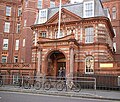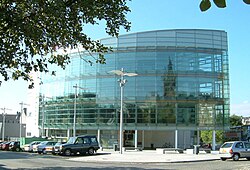| Name | University | Established | Notes | Degree awarded | Ref. |
|---|
| Aston Medical School | Aston | 2015 | | MBChB | [37] |
| Anglia Ruskin School of Medicine | Anglia Ruskin | 2018 | First intake of students took place in the academic year of 2018/9, with a cohort of 100 students per annum. | MBChB | [38] |
| St Mary's School of Medicine | St Mary's | 2026 | First intake of students expected in 2026/27. | MBBS | [39] |
| Hertfordshire Medical School | Hertfordshire | 2026 | First intake of students expected in 2026/27. | MBBS | [40] |
| University of Greater Manchester Medical School | University of Greater Manchester | 2025 | First intake of students expected in 2025/26. | MBChB | [41] |
| Barts and The London School of Medicine and Dentistry | Queen Mary
(University of London) | 1785 | Current school formed by the merger of the Medical College of St Bartholomew's Hospital and the London Hospital Medical College which was founded in 1785. Teaching at St Barts dates from 1123. | MBBS | [42] |
| University of Birmingham Medical School | Birmingham | 1825 | Formal medical education began at Birmingham in 1825 [17] Merged with Mason Science College in 1900. | MBChB | [43] [44] |
| Bristol Medical School | Bristol | 1833 | Merged with the University College, Bristol (now University of Bristol) in 1893. | MBChB | [45] |
| Brighton and Sussex Medical School | Brighton
Sussex | 2002 | Affiliated with both the University of Brighton and the University of Sussex. | BMBS | [46] |
| Brunel Medical School | Brunel | 2021 | Open to International students only. UK students have been eligible for entry since 2024. [47] | MBBS | [48] |
| University of Buckingham Medical School | Buckingham | 2015 | 4.5 year course, first cohort graduated in June 2019. January start date. Associated hospitals are: Milton Keynes University Hospital; Warwick Hospital (South Warwickshire NHS Foundation Trust) and Stoke Mandeville Hospital (Buckinghamshire Healthcare NHS Trust); St Andrews Hospital Northampton. | MBChB | [49] |
| School of Clinical Medicine, University of Cambridge | Cambridge | 1976 | Teaching of medicine began in 1540, but lay dormant for many years. An abortive attempt to put medicine on a proper footing was undertaken in the 1840s, but eventually petered out by the 1860s. It was not until 1976 in response to the recommendation of the Royal Commission on Medical Education that a complete medical course was re-established at Cambridge through partnership with Addenbrooke's Hospital in Cambridge. | MB BChir | [50] |
| UCLan School of Medicine | Preston | 2015 | The school works in very close partnership with NHS Trusts and CCGs in both Lancashire and Cumbria.Recruiting international students from 2015, sponsored UK students from 2017 and UK government funded students from 2018 onwards. | MBBS | [51] |
| Edge Hill University Faculty of Health, Social Care & Medicine | Edge Hill | 2019 | | MBChB | [52] |
| University of Exeter Medical School | Exeter | 2013
(Peninsula College: 2000) | Established after the split of the Peninsula College of Medicine and Dentistry. | BMBS | [53] |
| Hull York Medical School | Hull
York | 2003 | Affiliated with both the University of Hull and the University of York. | MBBS | [54] |
| Imperial College School of Medicine | Imperial College London | 1997
(Charing Cross Hospital: 1818) | Formed by the merger of St Mary's Hospital Medical School, the National Heart and Lung Institute, the Royal Postgraduate Medical School and the Charing Cross and Westminster Medical School. | MBBS | [55] |
| Keele University School of Medicine | Keele | 2003 | Founded as the Department of Postgraduate Medicine in 1978; began teaching undergraduate clinical medicine in 2003 using the Manchester curriculum. As such, the MBChB degree was awarded by the University of Manchester until 2011. From 2012 (2007 intake) the MBChB degree was awarded by Keele University itself. | MBChB (see comments) | [56] |
| Kent and Medway Medical School | University of Kent & Canterbury Christchurch | 2020 | The medical school has been formed as a collaboration between the University of Kent and Canterbury Christchurch University. The first cohort will consist of 150 students and is being supervised by Brighton and Sussex Medical School. | BMBS | [57] |
| King's College London GKT School of Medical Education | King's College London
(University of London) | 1988
(St Thomas's Hospital: 1550) | Result of a merger between King's College London and United Medical and Dental Schools of Guy's and St Thomas' Hospitals in 1998. Known as GKT School of Medicine until 2005. Teaching began in 1550 at St Thomas's Hospital Medical School. | MBBS | [58] |
| Lancaster Medical School | Lancaster | 2006 | Education undertaken by the Cumbria and Lancashire Medical and Dental Consortium. The MBChB degree was awarded by the University of Liverpool. The General Medical Council approved Lancaster in 2012 to deliver their own medical degree independently. Students starting after September 2013, will graduate with a Lancaster degree. | MBChB | [59] |
| Leeds School of Medicine | Leeds | 1831 | | MBChB | [60] |
| Leicester Medical School | Leicester | 1975 | | MBChB | [61] |
| Lincoln Medical School | Lincoln | 2018 | First students commenced in 2019. | BMBS | [62] |
| Liverpool Medical School | Liverpool | 1834 | | MBChB | [44] |
| Manchester Medical School | Manchester | 1824 | Medical teaching began in 1752 when Charles White founded the first modern hospital in the Manchester area, the Manchester Royal Infirmary. The medical school was first constituted in 1824. [63] | MBChB | [64] |
| Newcastle University Medical School | Newcastle | 1834 | Durham University College of Medicine 1851–1937, Medical School of King's College, University of Durham 1937–1963. Absorbed Durham University School of Medicine, Pharmacy and Health (est. 2001) in 2017. | MBBS | [44] |
| University of Nottingham Medical School | Nottingham | 1970 | Has an associated graduate school, the University of Nottingham Medical School at Derby. | BMBS | [65] |
| Norwich Medical School | East Anglia | 2000 | Medical school of the University of East Anglia | MBBS | [54] |
| Oxford University Medical School | Oxford | 1946 | Medicine has been taught at the University of Oxford sporadically since the 13th century but lay dormant through the 19th century. The current medical school, teaching both clinical and undergraduate students, was established in 1946. | BM BCh | [66] |
| Peninsula Medical School | Plymouth | 2013
(Peninsula College: 2000) | Established after the split of the Peninsula College of Medicine and Dentistry. | BMBS | [67] |
| UCL Medical School | University College London
(University of London) | 1998
(Middlesex Hospital: 1746) | A merger in 1987 between the medical schools of Middlesex Hospital (1746) and University College Hospital (1834), and a subsequent merger in 1998 with the Royal Free Hospital School of Medicine (founded as the London School of Medicine for Women in 1874) formed the present school. | MB BS | [68] [69] |
| Sheffield Medical School | Sheffield | 1828 | Affiliated with the Royal Hallamshire Hospital. | MBChB | [44] |
| Southampton Medical School | Southampton | 1971 | Students intercalate a Bachelor of Medical Sciences (BMedSci) degree within the 5 years of their course. An optional year-long Masters of Medical Science (MMedSci) intercalated degree is also on offer for students. | BMBS, BMedSci (see comments) | [70] |
| University of Sunderland School of Medicine | University of Sunderland | 2019 | A new medical school that utilises state-of-the-art clinical simulation. The first cohort of students started in September 2019. | MBChB | |
| University of Surrey School of Medicine | University of Surrey | 2024 | A new medical school offering a patient-centred, digitally-enabled and interprofessional 4-year programme for graduates. | BMBS | |
| City St George's, University of London | City St George's
(University of London) | 1733 | The second institution in England to provide formal medical education. | MBBS | [71] |
| Warwick Medical School | Warwick | 2000 | A graduate-entry course in medicine. Previously Leicester-Warwick Medical School. | MBChB | [72] [73] |
| Three Counties Medical School | Worcester | 2023 | A four-year, graduate-entry MBChB programme | MBChB | [74] |
| Chester Medical School | Chester | 2024 | A four-year, graduate-entry MBChB programme | MBChB | [75] |
| Black Country Medical School | Wolverhampton | under planning | under planning | under planning | [76] |
| Pears Cumbria School of Medicine | Cumbria
Imperial College London | 2025 | A four-year, graduate-entry MBBS programme, only for home students | MBBS | [77] |






